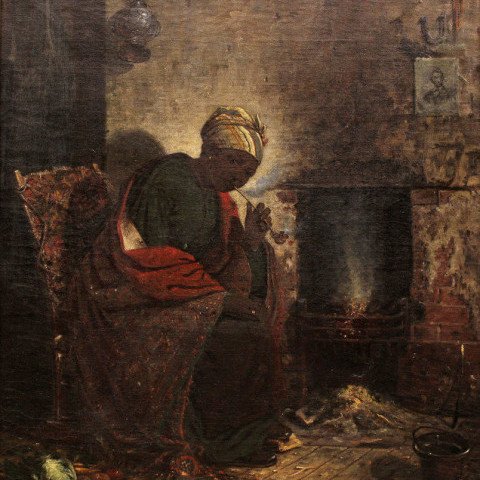Thomas Satterwhite Noble was born in Lexington, Kentucky, at a time when Lexington was the center of Kentucky's slave trade. Noble grew up on a plantation, where his father was a hemp and cotton farmer who also operated a rope and bagging factory in St. Louis, where slaves were used as hired hands through contract for hire arrangement with slave traders in Lexington. As a child, Thomas would play with the slave children that lived in small cabins at the back of the family home, and after dark listen to their elders tell ghost stories. Often he would bring biscuits in trade for an accompanied journey back to the main house after a night of scary ghost stories.
He attended Transylvania University and studied art with Oliver Frazer (1808-1864) and George P.A. Healy (1813-1894). In 1853, at the age of eighteen, he moved to New York City, and by 1856 he was studying art in Paris with the historical painter Thomas Couture from 1856 1859.
Noble returned to the United States in 1859. He was 26 at the start of the Civil War and despite his opposition to slavery, served as a captain in the Confederate Army, 1861 1865. After the Civil War, Noble returned to St. Louis in 1865 and explored the lives of freed slaves in America in a series of historical and allegorical paintings.
Noble opened a studio in New York City in 1866 and spent summers painting with George Inness in the Catskills. In 1857 he became an Associate of the National Academy and was appointed head of the McMicken School of Art in Cincinnati, Ohio in 1868. In 1881 he traveled to Munich, returning to Cincinnati in 1883 and later retired from McMicken School in 1904. He moved to Bensonhurst, New York and died in New York City in 1907.
Source:
Fine Art Dealers Association, www.fada.com
The Morris Museum, www.themorris.org
1. Birchfield, James, Albert Boime, and William Hennessy. Thomas Satterwhite Noble, 1835-1907. Lexington, KY: University of Kentucky Art Museum, 1988.
2. Pennington, Estill Curtis. A Southern Collection. Augusta, GA: Morris Communications Corporation, 1992.
3. Pennington, Estill Curtis. Look Away: Reality and Sentiment in Southern Art. Atlanta, GA: Peachtree Publishers, 1989.

